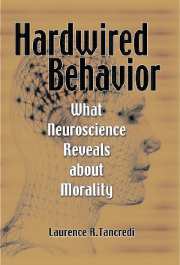Book contents
- Frontmatter
- Contents
- Preface
- Acknowledgments
- 1 Neuroscience and Morality
- 2 Morality and the Mind
- 3 Beyond the Mind Zone
- 4 The Moral Brain
- 5 Bad without Conscience
- 6 The Biology of Choice
- 7 Sex and the Single Moral Code
- 8 Brain Biology and Sex
- 9 Deception
- 10 The Biology of Money
- 11 The Bad and the Mad
- 12 Creating a Moral Brain
- Notes
- Glossary
- Index
10 - The Biology of Money
Published online by Cambridge University Press: 13 October 2009
- Frontmatter
- Contents
- Preface
- Acknowledgments
- 1 Neuroscience and Morality
- 2 Morality and the Mind
- 3 Beyond the Mind Zone
- 4 The Moral Brain
- 5 Bad without Conscience
- 6 The Biology of Choice
- 7 Sex and the Single Moral Code
- 8 Brain Biology and Sex
- 9 Deception
- 10 The Biology of Money
- 11 The Bad and the Mad
- 12 Creating a Moral Brain
- Notes
- Glossary
- Index
Summary
Let's assume you've just had a windfall and inherited a million dollars from a distant relative. The local real estate market has just undergone a major run-up, reaching higher levels than ever. Interest rates are very low; stocks have declined at least 42% from their high a few years ago, but all the indicators suggest they may rally in the near future. You are facing a very difficult decision: Should you keep the money in interest-bearing notes at a low 3%, invest in some solid Dow Jones stocks, put some of the money in high-risk securities, or consider buying a condominium?
Ask your brain: At least three areas of the brain affect monetary decisions – the amygdala and hippocampus; the frontal lobe, especially the prefrontal cortex; and the anterior cingulate cortex (along with the dorsolateral [top–side] area of the prefrontal cortex).
The amygdala is the brain's hot spot for emotions. Through its linkages with the sensory cortex and the frontal lobes, the amygdala quickly inspects and looks for dangers and attractions in the outside world. Once it has characterized the environment, it attaches an emotional importance to the stimulus, and then notifies the mind to act upon our emotions for our survival.
Fear and anger are two of the most powerful emotions generated by the amygdala, which plays a major role in conditioned fear, that is, fear derived from exposure to a fear-inducing or frightening object or situation. Confronting a frightening event, the amygdala will induce the secretion of adrenaline – which intensifies panic and is capable of causing the event to be embedded in memory.
- Type
- Chapter
- Information
- Hardwired BehaviorWhat Neuroscience Reveals about Morality, pp. 124 - 142Publisher: Cambridge University PressPrint publication year: 2005



